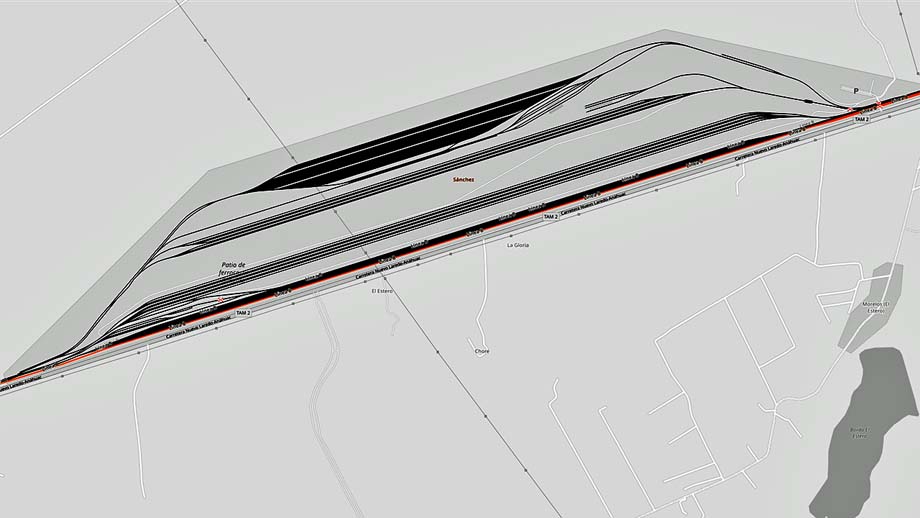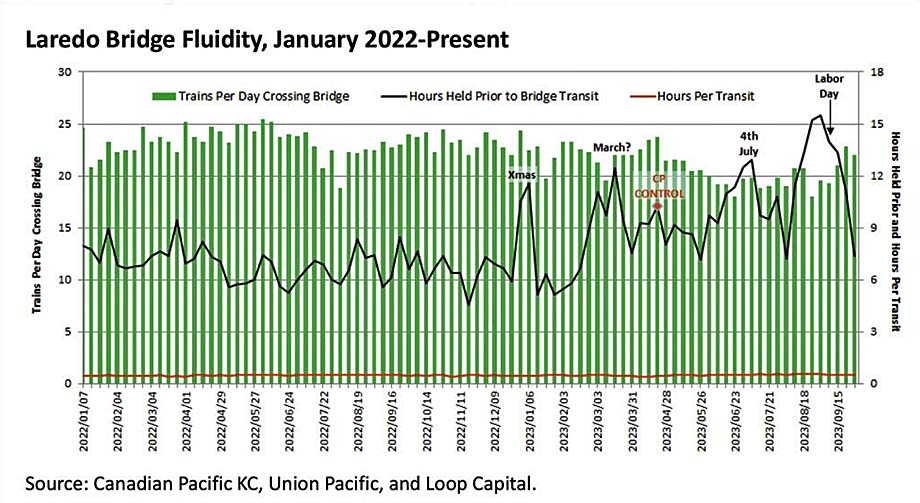
New York New York USA
Mexico - We've been following terminal dwell time at Canadian Pacific Kansas City's three primary
Mexican yards for months as we wait for CPKC's Mexican operation, which has been hamstringing financial results, to
turn around, and we might be seeing the first glimpses of it.
Average terminal dwell for the three high-volume Mexican yards (Sanchez, Monterrey, San Luis Potosi) dropped from 24.8
to 21.3 hours in the week ending 13 Oct 2023, which is a low we haven't seen since last November, and remained
relatively unchanged the week ending 20 Oct 2023 at 21.7.
Sequentially, from the week ending 6 Oct 2023, dwell at Sanchez dropped from 32.1 to 23.5 hours, and Monterrey fell
from 35.2 to 32.9 hours.
San Luis Potosi came down from 7.1 to 6.0 hours the week ending 13 Oct 2023, but rose to 8.8 in the most recent
week.
Why is dwell at SLP much lower than the other two?
It has a higher percentage of run-through trains, which do not perform work at yards, they only change
crews.
Some railroads exclude run-through trains from dwell calculations (BNSF and the former KCS, for example) but CPKC
includes it.
The STB reporting standard is to exclude it.
Before we all race off and double our investments in CPKC, we need to include a couple of important caveats:
- It's possible it's a blip or aberration. We typically wait for three weeks of changed data before highlighting a new trend, and the only reason we're jumping the gun here is due to the magnitude and directional consistency of the data (two of three yards materially improved)
- We're prematurely celebrating going from poor to average here. You can see in the chart that KCSM was running cars through these yards in 13 hours between September 2021 and February 2022, in contrast to 21 hours the week of 13 Oct 2023. Even if dwell has in fact inflected and sticks at these lower levels, there's still a lot of work to do. There's been a broad assumption that CPKC management will run the KCS and KCSM properties better than KCS management was able to do, but so far that hasn't been the case.
Laredo Gateway Efficiency
Starting on 15 Oct 2023 CPKC began filing data to the STB related to oversight of its KCS integration.
The main operational file is a spreadsheet that goes back five years, by week, and totals 45,000 rows.
While this feels like overkill, one thing that caught our eye was historical data related to the Laredo rail
bridge.
Laredo is highly significant in two ways.
First, it's by far the most important freight (both rail and truck) gateway between the U.S. and Mexico, hence
efficiency and fluidity here matters.
Laredo's importance will also grow if this whole near-shoring thing starts to gain momentum.
Second, Laredo is ground zero in the food fight between CPKC and Union Pacific on the back of the KCS
acquisition.
There are 10 weekly data points related to the Laredo bridge, and we've pulled out three that we show in the chart
below:

- The average number of trains per day crossing the bridge. Both CPKC and UP trains utilize the bridge, with a split
of 57 percent Union Pacific and 43 percent CPKC over the past twelve months;
- The average time trains are held waiting to cross the bridge. This is probably the most important one in terms of
fluidity. We often hear the railroads tout faster times through the gateway relative to trucks that must queue for
hours, but if the railroads are doing the same thing that advantage dissipates;
- The average time taken to transit the bridge/gateway.
What is the chart telling us?
First, the gateway transit times are very consistent (red line in the chart), averaging 29 minutes.
There's no correlation with how the broader networks are operating.
Second, the average trains per day number hasn't been growing in recent years (but trains have been getting
longer).
Even if we go back to 2018, daily transits were still in the low-20s.
The key takeaway in the chart is obviously the black line, representing how long trains are being held before entering
the gateway.
We've gone from six hours with decent consistently in 2022 to high volatility around a 10 hour average in
2023.
The problems started before CP took over on 14 Apr 2023.
Next week we'll unpack this data to show CPKC and UP separately to see which has been the main culprit.
Rick Paterson.
 Construction of the new bridge should eleviate any problem one
assumes.
Construction of the new bridge should eleviate any problem one
assumes.
(likely no image with original article)
(usually because it's been seen before)
provisions in Section 29 of the
Canadian Copyright Modernization Act.
